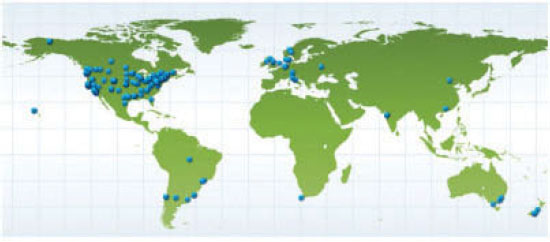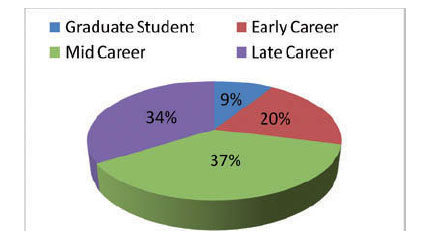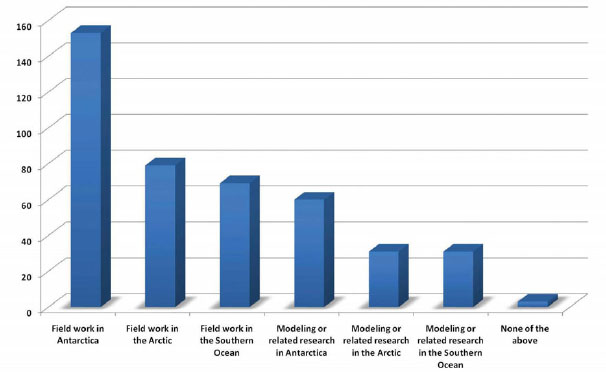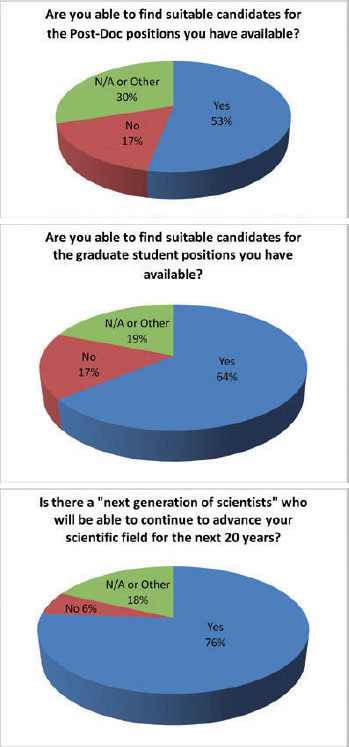Summary of Online Questionnaire Results
During the study process, a short online questionnaire was distributed widely (see Figure B.1) to draw upon the expertise and experience of the polar community. The questions provided an opportunity for respondents to identify the most important science questions for the coming decades and to share thoughts on the “next generation” of polar scientists. Following a short set of general background questions (career stage, scientific discipline), questionnaire respondents were asked the following questions:
• Within your own defined discipline, please list 3 important scientific questions that you believe will drive research in Antarctica and the Southern Ocean over the next 20 years.
• Across all disciplines, please list 3 important scientific questions that you believe will drive research in Antarctica and the Southern Ocean over the next 20 years.
• Please list any technology, infrastructure, or innovative logistics that you believe will play a major role in future research efforts in Antarctica and the Southern Ocean (including new, emerging technologies).

FIGURE B.1 Geographic locations of questionnaire respondents.
• How did you get into Antarctic and/or Southern Ocean science? Are similar pathways available to others today?
• Are you able to find suitable candidates (number, quality) for the Post-Doc positions you have available? If not, why?
• Are you able to find suitable candidates for the graduate student positions you have available? If not, why?
• Is there a “next generation of scientists” who will be able to continue to advance your scientific field for the next 20 years?
The questionnaire was distributed to approximately 1,000 people via various Antarctic and Arctic email distribution lists. There were a total of 205 respondents representing a variety of disciplines and backgrounds. Questionnaire respondents included graduate students (pre-Ph.D.) and early-career scientists, midcareer scientists, and late-career scientists (see Figure B.2). Most of the respondents have conducted field work in Antarctica and the Arctic. A number of questionnaire takers have conducted fieldwork in the Southern Ocean, and there were also respondents who have worked on modeling in Antarctica and the Southern Ocean (see Figure B.3).
Respondents represented a range of disciplines that were grouped into eight categories, as shown in Table B.1.
Questionnaire respondents were asked to identify three important science questions that will drive research in Antarctica and the Southern Ocean over the next 20 years. Approximately 600 answers to this question were received and they were grouped

FIGURE B.2 Distribution of the various career stages of questionnaire respondents.

FIGURE B.3 Questionnaire respondents have conducted fieldwork in both Antarctica and the Arctic. Some have also conducted fieldwork in the Southern Ocean and are involved in modeling or related research. Note that questionnaire respondents were permitted to select more than one option to answer the question, “Where have you conducted research?”
TABLE B.1 Respondents Represented a Range of Disciplines That Were Grouped into Eight Categories
| Discipline | Respondents (%) |
| Biology and ecosystems | 36 |
| Oceans and acidification | 16 |
| Geology | 15 |
| Astronomy and space physics | 12 |
| Ice and sea level rise | 10 |
| Atmosphere and climate | 6 |
| Technology | 3 |
| Other (incl. policy, psychology, art) | 2 |
into the following 14 themes: global climate change and sea level rise, ice sheets, ice shelves, Southern Ocean, sea ice, paleoclimate, atmosphere and climatology, biology, space weather and astronomy, geology, interdisciplinary question, extreme environments, scientific process, and human elements.
Respondents who identified themselves as a principal investigator (PI) or co-PI were asked how they originally began their career in Antarctic science and if those pathways are still available to others today. Approximately one-third of respondents became involved as a graduate student and, if undergraduate and postdoctoral experiences are included, this makes up about 50 percent of respondents. About 15 percent indicated that they became involved via an established colleague, and 10 percent answered that they wrote a proposal that was funded.
PIs were also asked if they were able to find the postdocs and graduate students that they needed. Over half said that they were able to find postdocs and graduate students. When asked if there was a “next generation” of scientists that would advance the scientific field, approximately three-quarters said yes (see Figure B.4).
Although this exercise was useful to inform the committee about the lessons learned, general concerns, and future goals of a broad cross section of scientists (with various experience levels and disciplines), this was not a systematic survey and the results should not be used as an official statement for the scientific community.

FIGURE B.4 Responses to the online questionnaire question regarding the availability of postdoctoral researchers, graduate students, and more generally a “next generation of scientists.” The majority of respondents indicated that there is a next generation to carry the science forward in the coming decades.






